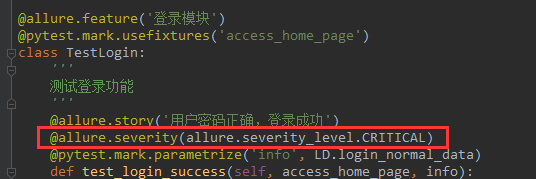参考资料:
安装allure:https://www.jianshu.com/p/8c2a696090cd
安装pytest:https://www.jianshu.com/p/8c2a696090cd
配置python virtualenv虚拟环境:https://www.jianshu.com/p/dc9501777225
pytest生成xml:https://www.jianshu.com/p/c5c9ad16b1bf
allure生成html报告:https://www.jianshu.com/p/7e3d0d7c3b38
直接使用命令行生成
allure generate ./reports/xml -o ./reports/html --clean
allure装饰器汇总:https://www.jianshu.com/p/93235504ce7f
allure输出报告的层级控制:https://www.jianshu.com/p/c92b936d65a2
allure tag标签:https://www.jianshu.com/p/93665779d983
allure报告添加附件:https://www.jianshu.com/p/ce411e44499a
参考博客:https://www.cnblogs.com/xiaogongjin/p/11705134.html
这里以allure+pytest进行讲解:
使用之前需要导入allure模块
import allure
1、feature--测试用例主要功能模块
使用pytest框架编写用例时,一般一个py文件内的一个class就是属于一个大模块,如果想在报告内显示单独的模块,在class类前使用方法@allure.feayure()方法



2、story——feature功能模块下的分支功能,使用方法:@allure.story()


3、severity——测试用例的严重级别
Allure中对严重级别的定义:
-
-
blocker级别:中断缺陷(客户端程序无响应,无法执行下一步操作)
-
critical级别:临界缺陷( 功能点缺失)
-
normal级别:普通缺陷(数值计算错误)
-
minor级别:次要缺陷(界面错误与UI需求不符)
-
trivial级别:轻微缺陷(必输项无提示,或者提示不规范)
-
使用方法:@allure.severity(allure.severity_level.CRITICAL) 或者 @allure.severity('critical')


4、step——测试用例的步骤
使用方法:[email protected]() 只能以装饰器的形式放在类或者方法上面 2.with allure.step(): 可以放在测试用例方法里面,但测试步骤的代码需要被该语句包含

